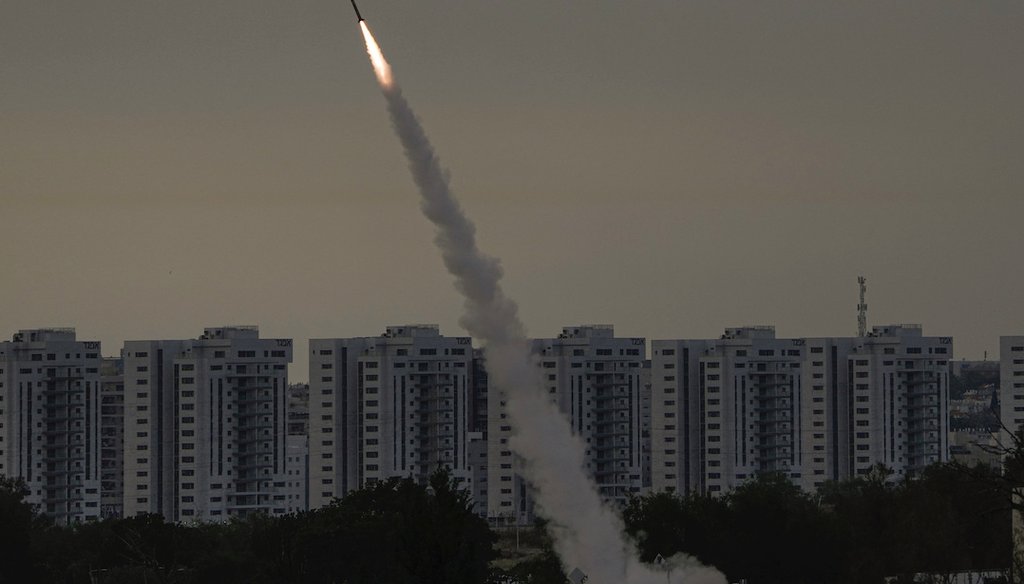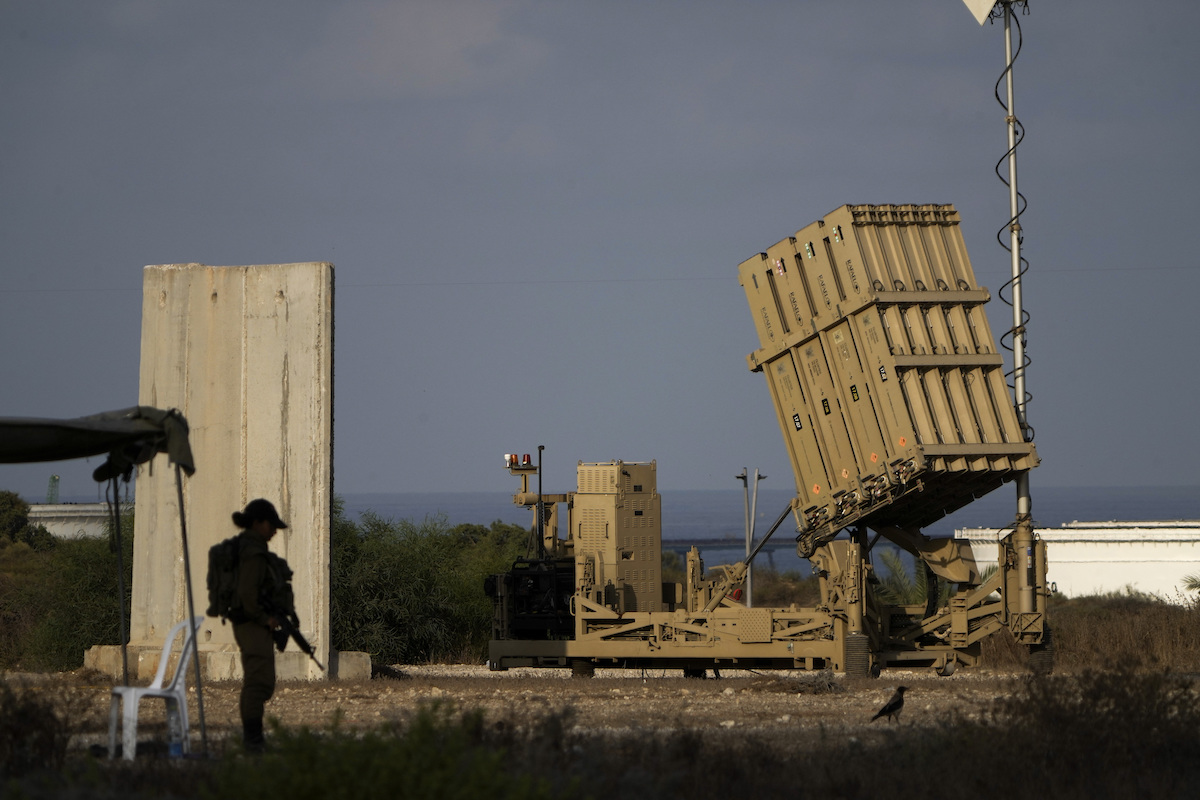Stand up for the facts!
Our only agenda is to publish the truth so you can be an informed participant in democracy.
We need your help.
I would like to contribute

Israel's Iron Dome anti-missile system fires near Ashkelon to intercept a rocket launched from the Gaza Strip, May 11, 2023. (AP)
If Your Time is short
-
The United States is using Iron Dome defenses in limited ways.
-
The Iron Dome is designed to combat threats such as those faced by Israel, a small nation hemmed in by enemies. Because the U.S. is larger and doesn’t have the same threats from its direct neighbors, the technology is less useful here.
-
Since the Cold War, the U.S. has faced the risk of intercontinental ballistic missiles from North Korea, Russia and China. It has sought, with mixed success, to establish missile defenses against those threats. An Iron Dome would be ineffective against such long-range missiles.
Republican presidential candidate Vivek Ramaswamy questioned why the United States doesn’t have an "Iron Dome" defense system like the one that is defending Israel against rockets fired from Gaza.
"We don’t have an Iron Dome in this country, yet, we’re vulnerable to nuclear missile attacks any given day," Ramaswamy, a businessman, said on Tucker Carlson’s Oct. 9 show on X. "And we’re marching closer into nuclear conflict in multiple parts of the world, most notably with Russia."
Carlson later replied, "How could you pay for a much-needed defense system in another country but not in your own country? I don’t understand that. How can you pretend to be a leader in your country if you're doing something like that? That seems so immoral to me."
Their conversation was premised on some misunderstandings about the U.S. missile defense strategy, but it touched on a key question of the moment: Why doesn’t the U.S. have Iron Dome technology as Israel does?
The U.S. military is investing in this technology, just not in the way you might picture it.
For the U.S., an Iron Dome’s usefulness is limited because the system is designed to combat threats such as those faced by Israel, a small nation hemmed in by enemies. The United States is much larger and doesn’t have the geopolitical concern that its direct neighbors will fire rockets on Americans.
An Iron Dome could not be counted on to counter long-range missiles with a nuclear warhead. The U.S. military has sought, with mixed success, to establish missile defenses against nuclear threats from rogue states and superpowers such as Russia or China.
The Iron Dome is Israel’s air defense missile system. It was developed in 2011 by Israeli companies, with significant U.S. financial investment. It is designed to shoot down incoming projectiles, such as rockets and artillery; it is not used to attack or retaliate.
This is how it works: Radar detects incoming rockets and sends information about projected paths to the command and control center. This component determines the threat level and whether the rockets are likely to strike inhabited areas. If the system concludes that there is a threat, an interceptor fires missiles from the ground to destroy the rockets in the air. Israel’s Iron Dome consists of multiple batteries and interceptors that can destroy hundreds of projectiles at once.
The U.S. has spent millions of dollars to help Israel deploy interceptors for the dome, experts said, and U.S. defense contractors such as General Dynamics Corp. and Raytheon Technologies Corp. have been deeply involved in the system’s manufacturing and development, along with Israeli industry. According to the Center for Strategic and International Studies, more than half of the system’s components are manufactured in the U.S.
The system is expensive to operate, especially amid hostilities. In 2023, the U.S. is slated to spend close to $80 million to acquire Iron Dome interceptors for Israel, and an equivalent amount was requested for the same purpose in 2024, said Jaganath Sankaran, an assistant professor at the University of Texas at Austin’s Lyndon B. Johnson School of Public Affairs and a trained mechanical engineer.
A battery of Israel's Iron Dome missile defense system in August 2022. (AP)
The U.S. has deployed an Iron Dome system, though for limited purposes.
In 2019, the U.S. Army bought two Iron Dome system batteries from Israel; they were delivered in 2020 and 2021. The Army intended to use them as an interim defense against cruise missiles as the service builds what it calls its "Indirect Fire Protection Capability" system — a mobile, ground-based weapons system designed to defeat cruise missiles, unmanned aircraft systems, rockets, artillery and mortars.
One of the batteries was sent in 2021 to Guam, a U.S. territory, to test, train and refine deployment capabilities, Defense News reported in March 2022. The other is at Joint Base Lewis-McChord, a training and mobilization center for all services, in Washington state.
In August 2023, the U.S. Marine Corps said it would acquire three more batteries and nearly 2,000 interceptor missiles from Israel, although the unfolding war between Israel and Hamas could change that.
Another potential American use of dome technology could be to protect overseas U.S. forces that are facing artillery rockets, said John Pike, director of globalsecurity.org, a Washington, D.C.,-based research group.
In general, though, the Iron Dome solves a problem that the U.S. does not have.
"The geography of Israel — its smaller area and close proximity of (militant groups) Hamas and Hezbollah in Gaza and southern Lebanon — makes the Iron Dome sensible for Israel," Sankaran said. "Mexico and Canada are not going to shoot at us, so why do we need it in the continental U.S.? And even if such a strike happened hypothetically, Iron Dome would not defend a country as large as the United States."
Military analysts said attacks from intermediate-range nuclear missiles or ICBMs are a significant concern for the U.S. But the experts added that an Iron Dome wouldn’t help there.
Iron Dome "is not designed for nor capable of intercepting nuclear warheads launched from intercontinental ranges," said retired U.S. Air Force Col. Dana Struckman, a Naval War College professor who said he spoke for himself and not the college or the military.
The U.S. has worked on missile defense systems for decades with mixed success, experts said. The U.S. has the Ground-Based Midcourse Defense (or GMD) system, which is designed to intercept ICBMs from North Korea. Its interceptors are in Alaska and California. It’s had some success in testing, said James Wells, a University of Michigan physicist, and there are plans to improve it.
Overall, though, U.S. missile defense capabilities are "modest," said Michael O’Hanlon, a senior fellow at the Brookings Institution, a think tank in Washington, D.C.
"Defending the U.S. homeland from very long range ballistic missiles is very hard technologically," said Brendan Green, a University of Cincinnati professor who has studied nuclear issues. "Current systems would attempt to intercept these missiles in outer space with conventional weapons. This is a very tough engineering problem, but even more importantly, it is a tough physics problem to discriminate warheads from decoys."
Alternatively, missile defense systems could pursue long-range missiles during the earlier "boost" phase when they are still in the atmosphere. "This is a much easier physics problem, but a more difficult intelligence problem, because your interceptors have to be very close to the missile and ready to fire very quickly," Green said.
Meanwhile, "theater missile defense" — defending allies, military bases or high-value systems such as aircraft carriers by intercepting missiles in the atmosphere — has a better chance at success, Green said. But they can still be defeated by sending so many missiles that the defense system can’t defend against them all, he said.
The technical challenge of defending against ICBMs has led the U.S. to focus more on mutually assured destruction as a deterrent than on missile defense, experts said. The idea is to make it "suicidal" for China, Russia or North Korea to attack the U.S. with nuclear weapons, Sankaran said.
Our Sources
X, Tucker Carlson video, Oct. 9, 2023
Defense News, US Army prepares to choose homes for Iron Dome weapons, March 29, 2022
Times of Israel, US successfully tests Iron Dome system it purchased from Israel, Aug. 2, 2022
Times of Israel, US Marines plan to procure 3 Iron Dome batteries, nearly 2,000 interceptor missiles, August, 26, 2023
CNN, The Iron Dome, explained and visualized, Oct. 11, 2023
AJC, 5 Things You Need to Know About Israel’s Iron Dome Defense System, Oct. 9, 2023
U.S. Army, INDIRECT FIRE PROTECTION CAPABILITY (IFPC) INCREMENT 2 – INTERCEPT BLOCK 1, updated 2022
Center for Arms Control and Non-Proliferation, Fiscal Year 2024 Defense Budget Request Briefing Book, April 4, 2023
Haaretz, "U.S. Marines tested Israel's Iron Dome. Here's what they really proved," Jul 31, 2022
Email interview with James Wells, physicist at the University of Michigan, Oct. 11, 2023
Email interview with Jaganath Sankaran, assistant professor at the University of Texas’ Lyndon B. Johnson School of Public Affairs, Oct. 11, 2023
Email interview with John Pike, director of globalsecurity.org, Oct. 11, 2023
Email interview with retired U.S. Air Force Col. Dana Struckman, professor at the Naval War College, Oct. 11, 2023
Email interview with Michael O’Hanlon, senior fellow at the Brookings Institution, Oct 11, 2023
Email interview with Brendan Green, professor at the University of Cincinnati, Oct. 11, 2023
Email interview with Tricia McLaughlin, spokesperson for Vivek Ramaswamy’s campaign, Oct. 11, 2023
















































